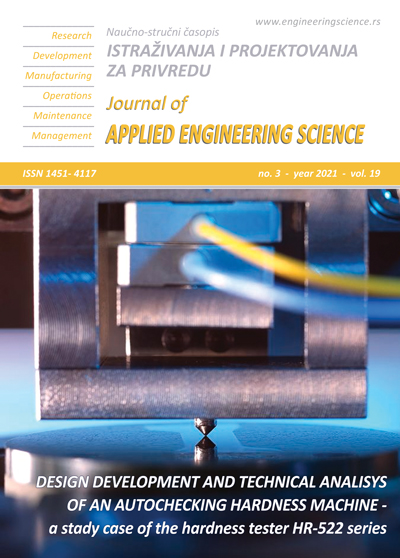STRUCTURAL CHANGES IN RUSSIA’S INDUSTRY: THE CURRENT SITUATION AND FORECAST
Abstract
Purpose: The objective of this paper is to analyze the dynamics of change in industrial production in Russia from 2008 to 2019 across a set of indicators characterizing structural changes in industry, specifically its extractive, manufacturing, and production and distribution of electricity, gas, and water sectors. Design/Methodology/Approach: The work provides a forecast of output in the three sectors of industry using methods such as Holt’s method and factor analysis, with structural shifts projected using the methods of Szalai, Ryabtsev, Gatev, and Kazinets.
Findings: The empirical results show further changes in the structure of industrial production in the Russian Federation and an increase in manufacturing production at the same time due to a decrease in production by the type of activity "Mining".
Practical Implications: Investors who plan to invest in the Russian Federation should bear in mind that investments in manufacturing production are advisable.
Originality/value: To initiate progressive structural changes, the development and qualitative transformation of the structure of the manufacturing industry is necessary
References
Abbas, S. A. 2018. Entrepreneurship and Information Technology Businesses in Economic Crisis, Entrepreneurship and Sustainability Issues 5(3):682-692. https://doi.org/10.9770/jesi.2018.5.3(20)
Araujo, R. A., & Lima, G. T. (2007). A structural economic dynamics approach to balance-of-payments-constrained growth. cambridge Journal of Economics, 31(5), 755–774.
Cadot O., Carrre C., Strauss-Kahn V. (2007). Export Diversification: What's Behind the Hump? / Centre for Economic Policy Research, Discussion Paper No 6590.
Chenery, H. B., & Taylor, L. (1968). Development patterns: among countries and over time. The Review of Economics and Statistics, 391–416.
Clark, C. (1957). The Conditions of Economic Progress Macmillan & Co. London, 108, 109.
Dasgupta, S. and Singh, A. (2006) Manufacturing, services and premature de-industrialisation in developing countries: a Kaldorian empirical analysis. ESRC Centre for Business Research, University of Cambridge.
De Vries, G., Timmer, M., & de Vries, K. (2015). Structural transformation in Africa: Static gains, dynamic losses. The Journal of Development Studies, 51(6), 674–688.
Diao, X., McMillan, M. and Rodrik, D. (2017) The recent growth boom in developing economies: A structural change perspective // National Bureau of Economic Research. No. w23132.
Di Meglio, G., Gallego, J., Maroto, A., & Savona, M. (2015). Services in Developing Economies: A new chance for catching-up?// SPRU Working Paper Series, SWPS 2015-32 (November).
Dondur, N., Pokrajac, S., Spasojević-Brkić, V., & Grbić, S.(2011). Decomposition of productivity and allocative efficiency in Serbian industry. FME Transactions, 39 (2), 73-78.
Federal State Statistic Service https://www.gks.ru
Fisher, A.G.B. (1939) Production, primary, secondary and tertiary//The Economic Record 15: 24–38.
Foster-McGregor N., Verspagen B. (2016) The Role of Structural Change in the Economic Development of Asian Economies// Asian Development Review, vol. 33, no. 2, pp. 74–93.
Harberger, A. C. (1998). A vision of the growth process. The American Economic Review, 88(1), 1–32.
Hausmann R., Hidalgo C.A. (2011) The network structure of economic output //Journal of Economic Growth.16:309–342.
Imbs, J., Montenegro C., Wacziarg R. (2014) Economic Integration and Structural Change//Mimeo. June 2014.
Humbatova, S.I., Tanriverdiev, S.M., Mammadov,I.N., Hajiyev, N. G.-O.2020. Impact of investment on GDPand non-oil GDPin Azerbaijan. Entrepreneurship and Sustainability Issues, 7(4),2645-2663. http://doi.org/10.9770/jesi.2020.7.4(6)
Kays, H. E., Karim, A. M., & Daud, M. R. C. (2020). A responsive multiplicative Holt-Winters approach for enhanced forecasting accuracy. International Journal of Industrial and Systems Engineering, 35(1), 114-134.
Koren, M. and Tenreyro, S. (2003) Diversification and development. FRB of Boston Working Paper. No. 3–3.
Kruger J.J. (2008) Productivity and Structural Change: a Review of the Literature //Journal of Economic Surveys.Vol. 22. No. 2. pp. 330–363.
Kuznets, S. (1973) Modern economic growth: findings and reflections. American Economic Review 63: 247–258.
Lewis, W. A. (1954). Economic development with unlimited supplies of labour. The manchester school, 22(2), 139–191.
Lin, J. Y. and Rosenblatt D. (2012). Shifting Patterns of Economic Growth and Rethinking Development.// Journal of Economic Policy Reform 15 (3): 171–194.
Matsuyama, K. (2009) Structural Change in an Interdependent World: A Global View of Manufacturing Decline //Journal of the European Economic Association, Vol. 7, No. 2/3.
Maslikhina, V. (2017). Spatial concentration of the manufacturing industry: Evidence from Russia. Journal of Applied Engineering Science, 15(4), 509-517.
McMillan, M., Rodrik, D. and Sepulveda, C. (2017) Structural change, fundamentals and growth: a framework and case studies // National Bureau of Economic Research. No. w23378.
McMillan, M., Rodrik, D., & Verduzco-Gallo, Í. (2014). Globalization, structural change, and productivity growth, with an update on Africa. World Development, 63, 11–32.
Meckl, J. (2002). Structural change and generalized balanced growth. Journal of Economics, 77(3), 241–266.
Pieper, U. (2003). Sectoral regularities of productivity growth in developing countries—a Kaldorian interpretation. Cambridge Journal of Economics, 27(6), 831-850.
Rodrik, D. (2003) Growth Strategies. Cambridge, MA: Kennedy School of Government, Harvard University.
Rodrik, D. (2013) Structural change, fundamentals and growth: an overview. Institute for Advanced Study. September.
Silva, E.G., Teixeira, Aurora A.C. (2008) Surveying structural change: Seminal contributions and a bibliometric account// Structural Change and Economic Dynamics. Vol.19. pp.273–300.
Romano, L., & Trau, F. (2017). The nature of industrial development and the speed of structural change. Structural Change and Economic Dynamics.
Szirmai, A. (2012) Industrialisation as an engine of growth in developing countries, 1950–2005. Structural Change and Economic Dynamics, 23(4), pp. 406–420.
Thirlwall, A.P. (2013). Economic Growth in an Open Developing Economy: The Role of Structure and Demand, Edward Elgar, Cheltenham.
Timmer, M.P. and de Vries, G.J. (2009) Structural change and growth accelerations in Asia and Latin America: a new sectoral data set. Cliometrica, 3(2), pp.165–190.
UNIDO (2016) United Nations Industrial Development Organization, Industrial Development Report. The Role of Technology and Innovation in Inclusive and Sustainable Industrial Development. Vienna: UNIDO.
Vu, K.M. (2017) Structural change and economic growth: Empirical evidence and policy insights from Asian economies// Structural Change and Economic Dynamics. 41. 64–77. W P 12 - 21. The Asian Development Bank (ADB).
Wells, H., & Thirlwall, A. P. (2003). Testing Kaldor's growth laws across the countries of Africa. African development review, 15(2-3), 89-105.
Xiong, Tao, Chongguang Li, and Yukun Bao. "Interval-valued time series forecasting using a novel hybrid HoltI and MSVR model." Economic Modelling 60 (2017): 11-23.

